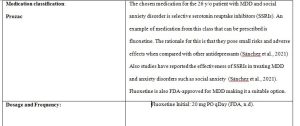Understanding that prescribing medication is not the same for all individuals is imperative to becoming a safe and effective psychiatric nurse practitioner. In clinical practice, you will see many patients in different stages of their lives and need to consider these in developing your prescribing treatment plan.
For this Assignment, you will choose a vulnerable patient and develop a 2- to 3-page Medication Guide for them and their family. In your guide, you will consider their ages, birth-assigned sex, FDA approvals, and considerations for increased or decreased risk for side effects. You will choose the most appropriate medication for each of these individuals. Support your answers with evidence-based, peer-reviewed scholarly literature. APA style format title page, citations and references will apply.
Note: You will not set up this Medication Guide as a paragraph-formatted paper but, instead, as a creative, visually appealing guide.
RESOURCES
Be sure to review the Learning Resources before completing this activity.
Click the weekly resources link to access the resources.
TO PREPARE FOR THIS ASSIGNMENT:
- Select a vulnerable patient from the list provided.
- Consider age, birth-assigned sex, FDA approvals, and risk and side-effect consideration.
- Select the most appropriate medication for your selected patient based upon the information provided.
- Review the textbook for commonly prescribed antidepressants, Fast Facts for Psychopharmacology for Nurse Practitioners.
- Conduct research through the FDA websiteLinks to an external site..
- Review prescriber information for professionals of the medications.
Note: These can be located free online with web search. - Review national guidelines for prescribing for these vulnerable individuals:
THE ASSIGNMENT
Step 1: Choose one of the following vulnerable patients to create a Medication Guide for the patient:
- Patient 1: 26-year-old female with a diagnosis of major depressive disorder and social anxiety disorder who is increasing in isolation and poor self-care. She is in her third trimester of pregnancy.
- Patient 2: 16-year-old male with a diagnosis of major depressive disorder, severe. He has seen a therapist weekly for the past 6 months and has had minimal change in symptoms. He has expressed thoughts of wanting to die.
- Patient 3: 72-year-old male with diagnosis of major depressive disorder and panic disorder. He has cardiac history and takes antihypertensive medications.
- Patient 4: 8-year-old Asian female with a diagnosis of severe depressive disorder presents to the office with a report of worsening symptoms. She has never taken psychotropic medication before.
Step 2: Create a Medication Guide for a patient. In your guide, you should provide the following specific instructions for the patient:
- Describe the chosen classification of medications, from the classification category, for your chosen vulnerable patient. Explain your rationale for your choice.
- Explain what dose you would start the chosen medication with and the frequency.
- Discuss how the medication works to treat their symptoms.
- Explain how long they should take the medication.
- Discuss the typical or common side effects of the medication.
- Explain the urgent or emergent considerations for the patient taking the medication.
The Medication Guide should also include:
- Directions you would provide the patient on how to take the prescribed medication
- Instructions on what the patient should do if a medication dose is missed
- List of any other medications, over-the-counter medications, and/or supplements/herbals the patient should avoid while taking the prescribed medication
- List of foods the patient should avoid when taking this medication
- Date when the patient should return for follow-up visit with you
- Discussion about the legal and ethical considerations for the medication being prescribed
- Answers in consideration of Social Determinants of Health on how you would:
- Assist the patient who cannot not afford to pay financially for the medication you are recommending/prescribing; and/or
- Has difficulty with transportation that impacts their ability to present for regular appointments with you
- Discuss how financial hardship and lack of transportation could relate to Social Determinants of Health, as well as why they are important considerations for you as a prescriber.
BY DAY 7 OF WEEK 3
Solution
Medication Guide for a pregnant patient with a diagnosis of major depressive disorder and social anxiety disorder

Click to purchase full solution